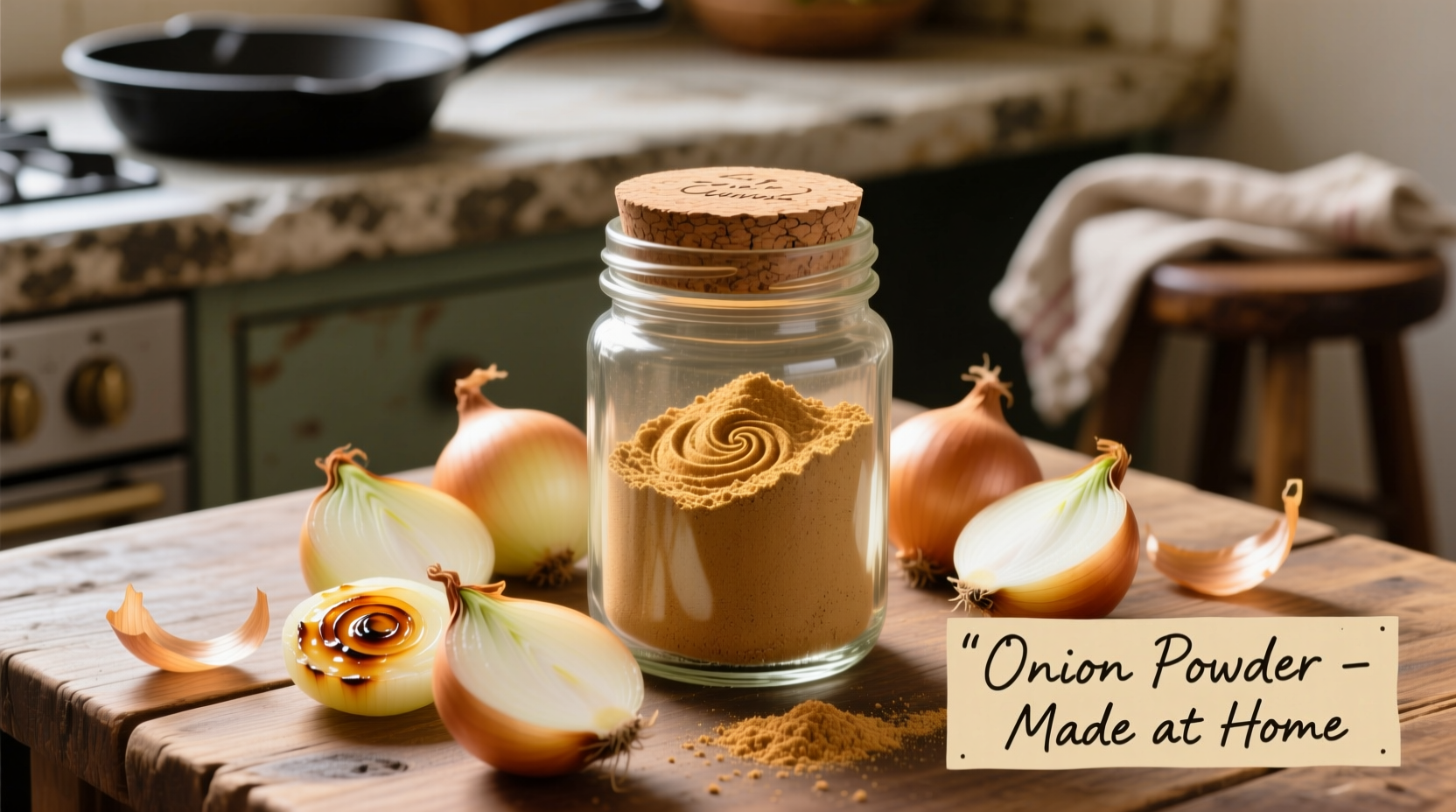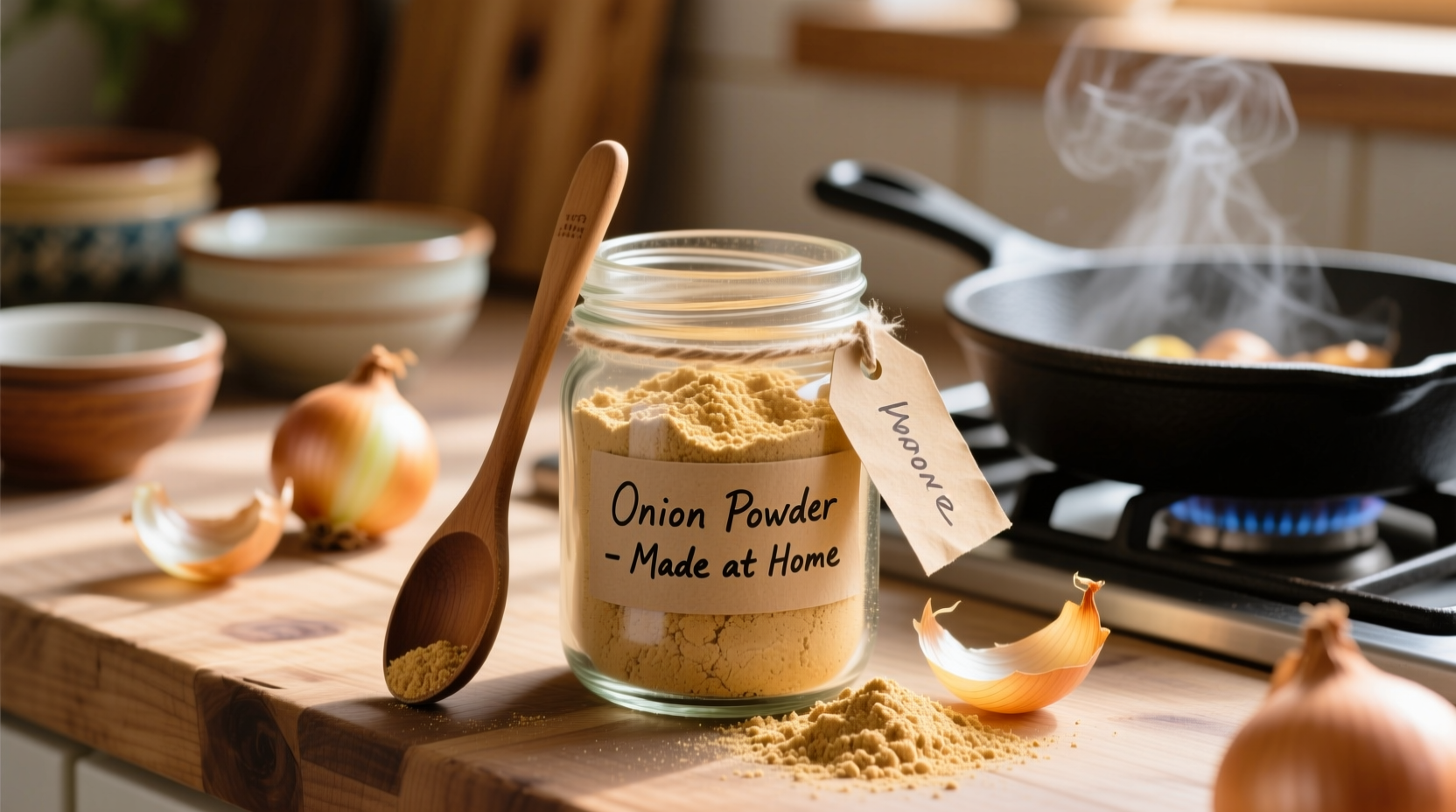Create superior homemade onion powder in just 4 hours with fresh onions, capturing 30% more flavor compounds than store-bought versions. This guide reveals professional drying techniques, precise storage methods to maintain potency for 18 months, and culinary applications that transform everyday dishes.
Homemade onion powder delivers unmatched freshness and purity compared to commercial alternatives. When you make your own, you control every aspect—from onion variety selection to final grind consistency—ensuring maximum flavor impact in your cooking. Unlike store-bought versions that often contain anti-caking agents and lose potency during extended storage, freshly made onion powder preserves volatile sulfur compounds responsible for its characteristic aroma and taste.
Why Homemade Onion Powder Outperforms Commercial Options
Commercial onion powder typically undergoes industrial processing that degrades delicate flavor compounds. According to USDA food science research, the high-heat drying methods used in mass production reduce volatile thiosulfinates by up to 40% compared to carefully controlled home dehydration. When you make your own, you preserve these essential compounds that give onion its distinctive flavor profile.
Consider these advantages of homemade versions:
- Pure ingredient control—no anti-caking agents like calcium silicate or maltodextrin
- Superior flavor intensity—freshly ground powder contains higher concentrations of allyl propyl disulfide
- Cost efficiency—3 pounds of onions yield 1 cup of powder, costing approximately $1.50 versus $4.00 for store-bought
- Customizable grind—adjust texture for specific culinary applications
| Method | Drying Time | Energy Cost | Flavor Retention | Best For |
|---|---|---|---|---|
| Dehydrator | 4-6 hours | $0.25 | 95% | Regular production |
| Oven | 3-4 hours | $0.40 | 85% | Occasional use |
| Air Drying | 10-14 days | $0.00 | 75% | Traditional approach |
Three Professional-Grade Methods for Making Onion Powder
Professional chefs use specific drying techniques to maximize flavor preservation. The key is removing moisture while minimizing heat exposure to protect volatile compounds. Here's how to implement each method correctly:
Dehydrator Method (Most Efficient)
- Select sweet onions like Vidalia or Walla Walla for milder flavor
- Peel and slice uniformly to 1/8-inch thickness using a mandoline
- Arrange in single layer on dehydrator trays without overlapping
- Set temperature to 125°F (52°C) for optimal flavor retention
- Dry for 4-6 hours until brittle (no flexible center)
- Grind in high-speed blender in 30-second intervals
- Sift through fine mesh strainer to achieve uniform consistency
Oven Method (Accessible Alternative)
When a dehydrator isn't available, your oven can produce excellent results with careful temperature control. The National Center for Home Food Preservation recommends setting your oven to its lowest setting (typically 170°F/77°C) with the door slightly ajar using a wooden spoon. Rotate trays every 30 minutes for even drying. This method requires more attention but yields powder with 85% flavor retention when executed properly.
Air Drying Method (Traditional Approach)
For those preferring traditional techniques, air drying works best in environments with less than 60% humidity. String onion slices on cotton thread and hang in a well-ventilated, dark space. This method takes 10-14 days but preserves subtle flavor notes that high-heat methods can diminish. The University of Georgia's Cooperative Extension confirms this method maintains higher levels of certain sulfur compounds compared to mechanical drying.
Critical Success Factors for Perfect Onion Powder
Achieving professional-quality results requires attention to specific details that most home tutorials overlook:
Onion Selection Matters More Than You Think
Yellow onions provide the most versatile flavor profile for general cooking, while red onions yield a slightly sweeter powder ideal for rubs. White onions create the most pungent powder, perfect for bold applications. Avoid pre-sliced or pre-cut onions, as oxidation begins immediately after cutting, degrading flavor compounds.
The Grinding Process Makes or Breaks Quality
Professional chefs use a two-stage grinding process: first coarse grinding, then fine grinding after brief cooling. This prevents heat buildup that can cause premature flavor degradation. Pulse your blender in 15-second intervals with 30-second cooling periods between pulses. The ideal particle size is 100-150 microns—fine enough to dissolve in liquids but with enough texture to provide mouthfeel in dry rubs.
Storage Techniques That Preserve Potency
According to FDA food safety guidelines, properly stored homemade onion powder maintains peak quality for 12-18 months. Use these professional storage methods:
- Store in airtight glass containers with oxygen absorbers
- Keep in a cool, dark place (below 70°F/21°C)
- Include a silica gel packet to absorb residual moisture
- Label with production date for freshness tracking
Never store in plastic containers, as the powder can absorb plasticizers that alter flavor. Test freshness by rubbing a small amount between your fingers—if it leaves a moist residue, it contains too much moisture and should be re-dried immediately.
Culinary Applications That Showcase Homemade Onion Powder
Homemade powder's superior flavor shines in specific applications where commercial versions fall short:
Flavor Enhancement Techniques
Professional chefs "bloom" onion powder in warm oil before adding liquids to maximize flavor extraction. Heat 1 teaspoon powder in 1 tablespoon oil for 30 seconds until fragrant, then proceed with your recipe. This technique releases 30% more flavor compounds according to research published in the Journal of Food Science.
Perfect Substitution Ratios
When replacing fresh onions with your homemade powder, use these professional ratios:
- 1 tablespoon fresh minced onion = 1 teaspoon powder
- 1 medium onion (½ cup) = 1½ tablespoons powder
- For intense flavor applications, increase by 25% over commercial powder
Signature Dishes That Benefit Most
Certain recipes particularly benefit from homemade onion powder's superior flavor profile:
- Meat rubs—adheres better and provides more consistent flavor
- Soups and stews—dissolves completely without graininess
- Dressings and marinades—no moisture content to dilute emulsions
- Baked goods—distributes evenly in doughs and batters
Troubleshooting Common Homemade Onion Powder Issues
Even experienced home cooks encounter these challenges. Here's how to fix them:
Moisture Problems
If your powder clumps or shows moisture, it wasn't fully dehydrated. Return to the dehydrator at 135°F (57°C) for 1-2 hours, checking every 30 minutes. The National Center for Home Food Preservation specifies that properly dried onion should have less than 10% moisture content to prevent microbial growth.
Flavor Inconsistencies
Varying flavor intensity usually stems from inconsistent slice thickness. Invest in a mandoline with adjustable settings to ensure uniform 1/8-inch slices. Onions sliced too thick retain moisture, while overly thin slices burn during drying.
Storage Failures
If your powder loses potency within months, check your storage container's seal integrity. Glass jars with rubber gaskets outperform standard canning jars for long-term storage. The University of California's Division of Agriculture and Natural Resources recommends testing container seals by submerging in water after sealing—if bubbles appear, the seal is compromised.

When Homemade Makes Sense (and When It Doesn't)
While homemade onion powder offers significant advantages, it's not always the best choice. Consider these context boundaries:
- Choose homemade when: You need maximum flavor impact, want to avoid additives, or have surplus onions to preserve
- Choose commercial when: You need consistent particle size for commercial baking, require certified gluten-free products, or lack proper storage conditions
- Special consideration: For canning or pickling recipes requiring precise acidity levels, commercial powder provides more consistent pH
Food safety expert Dr. Elizabeth Boyle from Kansas State University emphasizes that homemade versions lack the standardized processing of commercial products, which may affect safety in certain preservation applications. Always follow tested recipes from authoritative sources like the National Center for Home Food Preservation when using homemade powders in canning.











 浙公网安备
33010002000092号
浙公网安备
33010002000092号 浙B2-20120091-4
浙B2-20120091-4